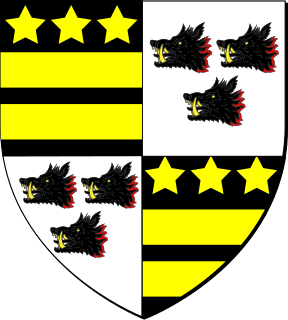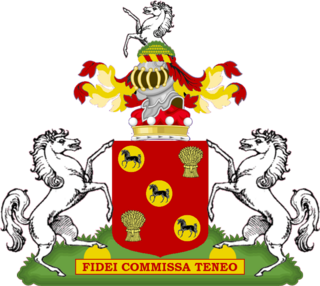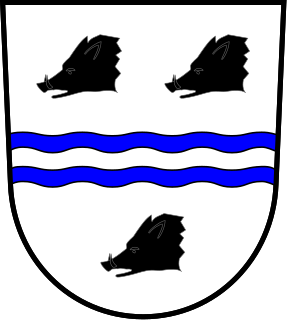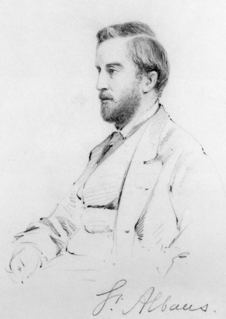Earl of Malmesbury is a title in the Peerage of Great Britain. It was created in 1800 for the diplomat James Harris, 1st Baron Malmesbury. The son of the grammarian and politician James Harris, he served as Ambassador to Spain, Prussia, Russia and France and also represented Christchurch in the House of Commons. Harris had already been created Baron Malmesbury, of Malmesbury in the County of Wiltshire, in 1788, and was made Viscount FitzHarris, of Hurn Court in the County of Southampton, at the same time he was given the earldom.

Baron Dudley is a title in the Peerage of England. It was created in circa 1440 for John Sutton, a soldier who served as Lord Lieutenant of Ireland. The title descended in the Sutton family until the 17th century when Frances Sutton, the heir apparent to the title, married Humble Ward, who, himself, was granted the title Baron Ward in 1644. Their heirs inherited both titles until 1740 when the differing rules of inheritance meant that the Barony of Dudley descended on Ferdinando Dudley Lea, who became the 11th Baron whilst the Barony of Ward went to John Ward, who later became 1st Viscount Dudley and Ward. On Ferdinando's death in 1757, the title fell into abeyance. The title was revived in 1916.
Viscount Mountgarret is a title in the Peerage of Ireland. It was created in 1550 for the Hon. Richard Butler, younger son of Piers Butler, 8th Earl of Ormond. His grandson, the third Viscount, was outlawed and excepted from pardon in 1652, one year after his death. His son, the fourth Viscount, received a pardon for all treasons and rebellions from King Charles II and was restored to his estates. He was succeeded by his son, the fifth Viscount. He was a supporter of King James II and led the Siege of Derry in 1688 to 1689. Lord Mountgarret was taken prisoner and outlawed, with his estates forfeited. However, in 1715 the outlawry was reversed and in 1721 he claimed his seat in the Irish House of Lords. His great-grandson, the eleventh Viscount, represented County Kilkenny in the Irish House of Commons. He was succeeded by his son, the twelfth Viscount. He was made Earl of Kilkenny in the Peerage of Ireland in 1793. The earldom technically became extinct on his death in 1846, when he was succeeded in the viscountcy by his nephew, the thirteenth Viscount. Despite the official title version, members of the Butler family have been known to refer to themselves as the rightful heirs to both the earldom and dukedom of Kilkenny. His son, the fourteenth Viscount, assumed in 1891 by Royal licence the surname of Rawson-Butler and the arms of Rawson when he inherited the Nidd Hall estate but in 1902 he resumed by Royal licence the surname of Butler only. In 1911 he was created Baron Mountgarret, of Nidd in the West Riding of the County of York, in the Peerage of the United Kingdom. As of 2017 the titles are held by his great-great-grandson, the eighteenth Viscount, who succeeded his father in 2004. He is understood to be the likely heir to the ancient earldom of Ormond as well as to the 16th century earldom of Ossory, but has not successfully proven the claim.

Baron Carrington is a title that has been created three times, once in the Peerage of England, once in the Peerage of Ireland and once in the Peerage of Great Britain. The first creation came in the Peerage of England in 1643 in favour of Sir Charles Smyth. Only a few days later he was created Viscount Carrington in the Peerage of Ireland. For more information, see this title.

Baron Carbery, of Carbery in the County of Cork, is a title in the Peerage of Ireland. It was created in 1715 for George Evans, with remainder to the heirs male of his father and namesake George Evans, a supporter of William and Mary during the Glorious Revolution, who had earlier declined the offer of a peerage. After his elevation to the peerage Lord Carbery represented Westbury in the House of Commons. He was succeeded by his eldest son, the second Baron. He also sat as Member of Parliament for Westbury. His grandson, the fourth Baron, briefly represented Rutland in Parliament. He was succeeded by his uncle, the fifth Baron. On his death the line of the eldest son of the first Baron failed. He was succeeded by his first cousin once removed, the sixth Baron, who had previously succeeded his father as second Baronet, of Castle Freke. Lord Carbery sat in the House of Lords as an Irish Representative Peer from 1824 to 1845. His nephew, the eighth Baron, was an Irish Representative Peer from 1891 to 1894. As of 2014 the titles are held by the latter's great-great-grandson, the twelfth Baron, who succeeded his father in 2012.
Baron Lisle was a title that was created five times in the Peerage of England during the Middle Ages and Tudor period. The earliest creation was for the family of Lisle of Rougemont, which bore arms: Or, a fess between two chevrons sable. The later creation of 1357 was for Lisle of Kingston Lisle, a younger branch of the Lisles of Rougemont. Robert de Lisle of Rougemont married Alice FitzGerold, the heiress of Kingston in the parish of Sparsholt, Berkshire. In 1269 Alice granted the manor of Kingston to her younger son Gerard I de Lisle, whose family adopted the arms of FitzGerold: Gules, a lion statant guardant argent crowned or. Gerard I's grandson was Gerard II de Lisle (1305–1360), created Baron Lisle in 1357.

Baron Stamp, of Shortlands in the County of Kent, is a title in the Peerage of the United Kingdom. It was created in 1938 for the civil servant, industrialist, economist, statistician and banker, Sir Josiah Stamp. The second Baron, Wilfred Carlyle Stamp, holds the record for having held a peerage for the shortest length of time. On 16 April 1941, the first Baron Stamp was killed by a German bomb, as was his son Wilfred. Legally, the son was presumed to have died a fraction of a second after his father, and therefore is supposed to have succeeded to the title for that short amount of time. The second Baron was succeeded by his younger brother, the third Baron. As of 2017 the title is held by the latter's son, the fourth Baron, who succeeded in 1987. Like his father he is a physician.

Baron Mountevans, of Chelsea in the County of London, is a title in the Peerage of the United Kingdom, created in 1945 in favour of the celebrated Antarctic explorer, Admiral Sir Edward Evans. As of 2017 the title is held by his grandson, the fourth Baron, who succeeded his brother in 2014.

William Amelius Aubrey de Vere Beauclerk, 10th Duke of St Albans, PC DL, styled Earl of Burford until 1849, was a British Liberal parliamentarian of the Victorian era.
Henry Pole, 1st Baron Montagu, the only holder of the title Baron Montagu under its 1514 creation, was one of the relatives whom King Henry VIII of England had executed for treason.

Lowry Egerton Cole, 4th Earl of Enniskillen,, styled Viscount Cole from 1850 to 1886, was an Irish peer and Conservative Member of Parliament.
Sir Thomas Charlton Meyrick, 1st Baronet KCB, known as Thomas Charlton until 1858, was a Welsh Conservative Member of Parliament.

The FitzHerbert baronetcy, of Tissington in the County of Derby, is a title in the Baronetage of Great Britain. It was created on 22 January 1784 for William FitzHerbert, of Tissington Hall, Derbyshire.
Sir John Parnell, 1st Baronet, was an Irish politician and a baronet.
Charles Henry Allsopp, 6th Baron Hindlip is a British peer and businessman, a member of the House of Lords from 1993 until 1999.
Ronald Charles Grant, 10th Baron de Longueuil was born on 13 March 1888 at Pau, France. He was the son of John Moore Charles de Bienville Grant. He married Ernestine Hester Maud Bowes-Lyon, daughter of the Hon. Ernest Bowes-Lyon and Isobel Hester Drummond, on 4 October 1918. He was educated at Elizabeth College, Guernsey. He was in the French Foreign Legion and was a civil engineer.
John Charles Moore de Bienville Grant, 9th Baron de Longueuil was born in 1861 at Bath, Somerset. He was the son of Charles James Irwin Grant and Anne Marie Catherine Trapman. He succeeded to the title of Baron de Longueuil on 3 August 1931. He died on 17 October 1935 at Pau, France.
Charles William Grant was born in 1782. He was the son of Captain David Alexander Grant and Marie-Charles-Joseph Le Moyne, Baronne de Longueuil. He married Caroline Coffin, daughter of General John Coffin and Anne Mathews, in 1813. He became a member of the Legislative Council of Lower Canada. He succeeded to the title of Baron de Longueuil on 17 January 1841. He died on 5 July 1848 at his residence of Alwington House in Kingston.









